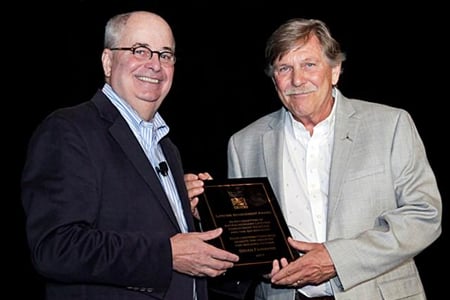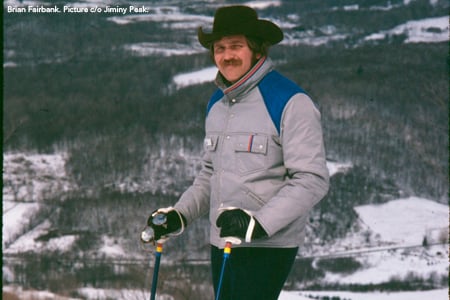A Berkshire Hall of Famer

In 2017, Brian (right) received the Lifetime Achievement Award from NSAA. Michael Berry (left), the former President of NSAA, presents. Picture c/o Jiminy Peak.
Every July 7th is an important day for Brian Fairbank. It was on that day in 1969 that he arrived in the Berkshires for a job interview at Jiminy Peak Mountain Resort with Fred Crane Jr. Fred needed to focus on the family business, Crane Paper, and wanted to hire someone he could trust to manage the ski resort. Brian landed the job, as well as Crane’s friendship and mentorship. In the years since, Fairbank has transformed Jiminy Peak into the largest ski and snowboard resort in southern New England, in addition to creating innovations in snowsports operations that would lead to national recognition, and somehow finding the time to take part in endeavors that would shape the development of the region he’s come to call home.
Brian has seen significant change in his time at the helm of Jiminy Peak. When he arrived in 1969, Jiminy Peak’s payroll included Fairbank and four other staff members and the resort saw approximately 30,000 skiers each winter. Now, the staff numbers near a thousand during the winter, all of whom support upwards of 200,000 skiers. Over the years, Fairbank saw changes to the Berkshires, and to the ski industry as well. “Tourism in the Berkshires has grown exponentially,” he notes, referring to long-standing attractions like Tanglewood and Jacob’s Pillow being joined by MASS MoCA, an expanded Clark Art Institute, along with numerous hotels, motels, restaurants, and other tourist attractions. Beginning in 1978, Jiminy Peak started to also operate in the summer, which has since become a larger trend in the national ski industry. Across the board, ski areas have added aerial parks, zip lines, mountain biking trails, mountain coasters and more to ensure year-round income streams and keep people enjoying the outdoors.
Jiminy Peak has been at the forefront of many such trends within the ski industry. As a member and Chairman of the Board of Directors of the National Ski Areas Association (NSAA), Brian was well-positioned to share ideas developed at Jiminy Peak with the industry as a whole. These included using shorter parabolic skis to teach beginners and creating a dedicated learning area on the mountain for novices, separating them from more experienced skiers. These innovations have since become common practice throughout the industry.

Brian skiing in 1975. Picture ℅ Jiminy Peak.
Additionally, Brian is proud of the resort’s focus on environmental stewardship, saying that Jiminy’s leadership asked themselves: “How can we be more efficient and protect the planet?” From the installation of energy-efficient LED trail lighting to adding some of the most advanced energy-saving snowmaking technology on the planet, Jiminy Peak has reduced its energy consumption significantly since the 1990s. In 2007, the mountain became the first ski resort in the United States to invest in its own megawatt-class wind turbine, and in 2015 added a 2.3-megawatt community solar facility. Through these renewable energy sources and conservation efforts, Jiminy Peak has reduced its energy consumption from the grid by 100% since 2006. Now, 100% of Jiminy Peak’s electrical demands are fulfilled through renewable measures.
These innovations have not gone unnoticed by the industry at large. In addition to Silver Eagle (1994) and Golden Eagle (2008) awards recognizing environmental stewardship, Jiminy Peak was awarded the Climate Change Impact Award from the NSAA in 2019 in recognition of its sustainability efforts. Additionally, Brian has received personal recognition from his industry peers. He was honored with the 2017 Lifetime Achievement Award by the NSAA, which cited “his enthusiasm for the sport, passion and commitment to the growth of the industry, and his overall zest and infectious good humor.” Most recently, the U.S. Ski and Snowboard Hall of Fame announced in September that Brian was named for induction in the Class of 2020.“I was truly honored to be inducted into the Hall of Fame,” he says, adding “it’s a pinnacle of my career, the result of 300 people in the industry voting for me.” He notes that the NSAA Lifetime Achievement Award and Hall of Fame are the result of “a continuous love and appreciation for the industry and the people who make it up.”
Closer to home, Brian has been no less dedicated. In the 1980s, he was the President of the Berkshire Visitors Bureau, and he served on the Board of Berkshire Health Systems in the 1990s. He spent several years as a member of the Board of Directors of HospiceCare in the Berkshires, working to get a hospice house built in the Berkshires. The effort did not succeed, but in the end, HospiceCare in the Berkshires merged with Berkshire Health Systems, which Brian identifies as “a fabulous outcome, allowing hospice to serve more people more effectively.”
This dedication is a reflection of his passion for the region. “It’s home for me,” Fairbank says. “I’ve got many friends and relationships with people that have stood the test of fifty years. They make a difference.” He is “enamored with the people that care so much and make a difference in the Berkshires,” citing leaders and visionaries at organizations like Berkshire Health Systems, MASS MoCA, and the Berkshire Innovation Center.
Brian identifies the Berkshires’ beautiful landscape as one of his favorite things about living here, and believes that it bodes well for the region’s future. He thinks COVID-19 has put a new spotlight on the ways people approach the outdoors. “People are eager to get out and do things with friends and family in fresh air, and I think this will help to put heads in beds and people in restaurants.”
Although Brian has a vacation home on Lake Winnipesaukee in New Hampshire, where he spends a few months of the year enjoying several sports on the water, Brian still loves to ski and hike in the Berkshires. So, if you find yourself coming to Jiminy Peak to enjoy some fresh powder this winter, keep an eye out. You may find yourself skiing next to a Hall of Famer!

